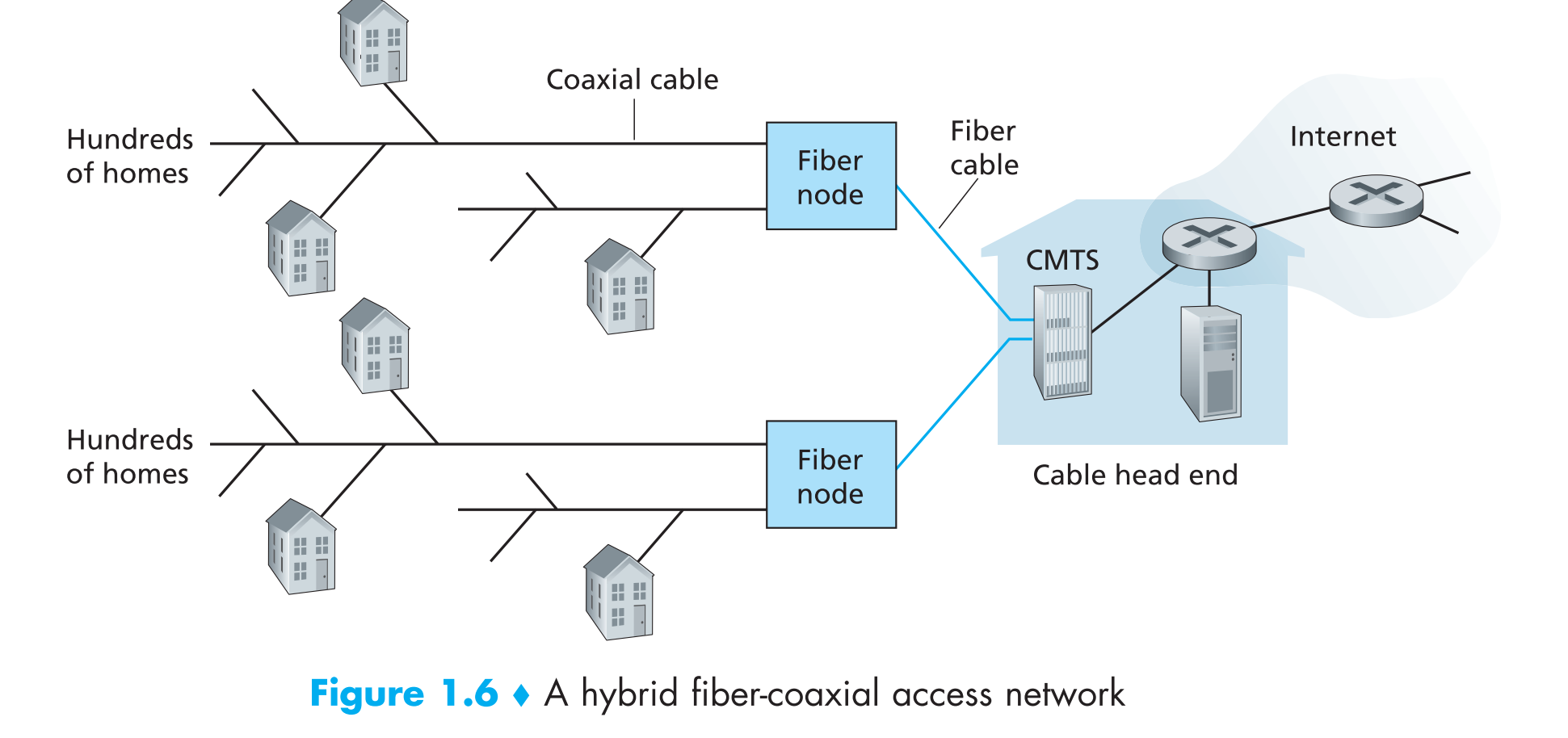1.1.3 What’s Protocol?
A protocol defines the format and the order of messages exchanged between two or more communicating entities, as well as the actions taken on the transmission and/or receipt of a message or other event.
1.2 Network Edge
end systems = hosts (Two categories: clients and servers)
Today, most of the servers from which we receive search results, e-mail, Web pages, and videos reside in large data centers.
1.2.1 Access Networks
The access network: the network that physically connects an end system to the first router (also known as the “edge router”) on a path from the end system to any other distant end system.
Home Access
Today, the two most prevalent types of broadband residential access are digital subscriber line (DSL) and cable.
DSL: 数字用户线路,是以电话线为传输介质的传输技术组合。
DSLAM: DSL access multiplexer
Fiber optics connect the cable head end to neighborhood-level junctions, from which traditional coaxial cable is then used to reach individual houses and apartments.
Because both fiber and coaxial cable are employed in this system, it is often referred to as hybrid fiber coax (HFC).
Coaxial cable: 同轴电缆
cable modem termination system (CMTS)
Ethernet and Wi-Fi
LAN: local area network
Although there are many types of LAN technologies, Ethernet is by far the most prevalent access technology.
Wide-Area Wireless Access: 3G and LTE
LTE: Long-Term Evolution 长期演进技术
1.2.2 Physical Media
Physical media fall into two categories: guided media and unguided media.
With guided media, the waves are guided along a solid medium, such as a fiber-optic cable, a twisted-pair copper wire, or a coaxial cable. With unguided media, the waves propagate in the atmosphere and in outer space, such as in a wireless LAN or a digital satellite channel.
- Twisted-Pair Copper Wire
- Coaxial Cable
- Fiber Optics
high-speedoperation, low error rate - Terrestrial Radio Channels
- Satellite Radio Channels
geostationary satellites, low-earth orbiting (LEO) satellites
1.3 Network Core
1.3.1 Packet Switching
packet switches (for which there are two predominant types, routers and link layer switches)
Store-and-Forward Transmission
The packet switch must receive the entire packet before it can begin to transmit the first bit of the packet onto the outbound link.
Queuing Delays and Packet Loss
output buffer
In addition to the store-and-forward delays, packets suffer output buffer queuing delays.
Packet loss may occur when buffer is completely full.
Forwarding Tables and Routing Protocols
Each router has a forwarding table that maps destination addresses (or portions of the destination addresses) to that router’s outbound links.
The Internet has a number of special routing protocols that are used to automatically set the forwarding tables.
Ad. & Disad.
- great for bursty data (resource sharing, simpler)
- excessive congestion possible.
1.3.2 Circuit Switching
In circuit-switched networks, the resources needed along a path (buffers, link transmission rate) to provide for communication between the end systems are reserved for the duration of the communication session between the end systems.
e.g. traditional telephone networks
guaranteed constant rate
Multiplexing in Circuit-Switched Networks
A circuit in a link is implemented with either frequency-division multiplexing (FDM) or time-division multiplexing (TDM).
频分/时分多路复用
1.3.3 A Network of Networks
- regional ISPs
- tier-1 ISPs
- PoP: points of presence, a group of one or more routers (at the same location) in the provider’s network where customer ISPs can connect into the provider ISP.
- Any ISP (except for tier-1 ISPs) may choose to multi-home, that is, to connect to two or more provider ISPs.
- ISPs at the same level of the hierarchy can peer. When two ISPs peer, it is typically settlement-free, that is, neither ISP pays the other.
- Internet Exchange Point (IXP): a meeting point where multiple ISPs can peer together.
- content provider networks
见P61 图片
1.4 Delay, Loss, and Throughput in Packet-Switched Networks
1.4.1 overview
Processing Delay
The time required to:
- examine the packet’s header and determine where to direct the packet
- check for bit-level errors in the packet
(on the order of microseconds)Queuing Delay
The number of packets that an arriving packet might expect to find is a function of the intensity and nature of the traffic arriving at the queue.Transmission Delay
L/RPropagation Delay
d/s
1.4.2 Queuing Delay and Packet Loss
traffic intensity: La/R (a: the average rate at which packets arrive at the queue, in units of packets/sec)
Golden rule: Design your system so that the traffic intensity is no greater than 1.
As the traffic intensity approaches 1, the average queuing delay increases rapidly.
Packet Loss
1.4.3 End-to-End Delay
Traceroute
1.4.4 Throughput in Computer Networks
When transferring a large file from Host A to Host B, the instantaneous throughput at any instant of time is the rate (in bits/sec) at which Host B is receiving the file.
Average throughput: F/T bits/sec